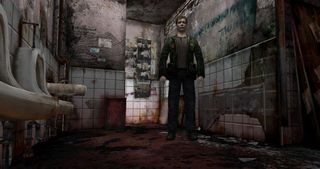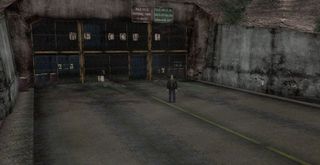On The Level: The town of Silent Hill, as seen in Silent Hill 2

In each chapter of the On The Level series, Andy Kelly celebrated a great map, level, or location from a classic PC game.
Silent Hill is a faded photograph of a town. You can see the traces of life, but they're faint, indistinct. People lived here once, but now it's a dead place, swallowed by fog and infected with some terrible evil. There are sights you'd see in any American town—school buses, gas stations, red fire hydrants. But also things that are alien and inexplicable. Cavernous cracks in the road, cryptic poems scrawled in blood, and that dense, pervading fog, which swirls and chokes the empty streets.
It's scary because it's normal. We look at Silent Hill and we understand it, which makes the parts that don't make sense even more surreal. Filmmaker David Lynch is known for his marriage of the mundane and the otherworldly, like the shadowy forces lurking in the woods around the idyllic town of Twin Peaks. This is an obvious influence on Team Silent, who built on this idea by making the town itself the source of the evil. There are pages of backstory about why Silent Hill is like it is, but none of it really matters. All you have to know is that this is a place where sinners are lured and judged.

Like all evil places, Silent Hill has a dark and storied history, remnants of which can be found scattered around the town. The games never force you to learn its history, but curious players can piece it together by reading notes and exploring. We learn of a plague that wiped out many of its earliest settlers, a brutal Civil War prison camp, and multiple cases of people mysteriously vanishing around Toluca Lake, the large body of water around which the town is built. It's never explicitly revealed why the town is such a lodestone for darkness and calamity, but the Native Americans considered it a sacred place before it was violently colonised by European settlers in the 17th Century.
While there's something strangely serene about the fogbound streets of Silent Hill, the shift to the Otherworld, heralded by the eerie wail of an air raid siren, is anything but. Here the town is plunged into darkness and transforms into a mutated, rust-caked shadow of its former self. Any Silent Hill fan will know the feeling of dread that comes with that siren. The Otherworld is overwhelmingly bleak, with the sound of pounding, grinding machinery filling the air and shapeless lumps of flesh strung up on bloody barbed wire fences. In comparison, the 'real' Silent Hill almost feels peaceful.

It's no surprise that some of the worst places in Silent Hill are hospitals. The town seems to feed on pain and suffering, of which these old buildings have had their fill. The transition from the town, where the whistle of the wind is constant, to the stark silence of a building interior is jarring. As you creep through the dark, your flashlight making long shadows dance around the room, the echoing sound of your footsteps is deafening. The games feel like they're covered in a thick, sickly layer of grime—a result of Team Silent's masterful art direction and texture work. Spend long enough in one of these rotten, forgotten places and you'll long to be back on the monster-filled streets.
Silent Hill is a place I think about a lot. It's one of the most evocative and atmospheric settings in games, and sadly wasted on a series of increasingly underwhelming sequels. Although Team Silent obviously borrowed many of the series' most striking themes and visuals from other sources—including, famously, Adrian Lyne's brilliant horror film Jacob's Ladder—they took them, twisted them, and made their own beautiful, monstrous masterpiece. With Team Silent gone forever, I may never go back, but I'll always have that faded photograph of the town in my memories.
PC Gamer Newsletter
Sign up to get the best content of the week, and great gaming deals, as picked by the editors.
If it’s set in space, Andy will probably write about it. He loves sci-fi, adventure games, taking screenshots, Twin Peaks, weird sims, Alien: Isolation, and anything with a good story.

Helldivers 2 dev warns players not to 'fall in love' with datamined content that might never come out: 'Some are ancient leftovers, some are things that will pop up in the game'

'Just the right kind of weird:' How the secret weapon of a /pizza command let EverQuest 2 slice into WoW and accidentally end up topping Pizza Hut on Google
Most Popular


